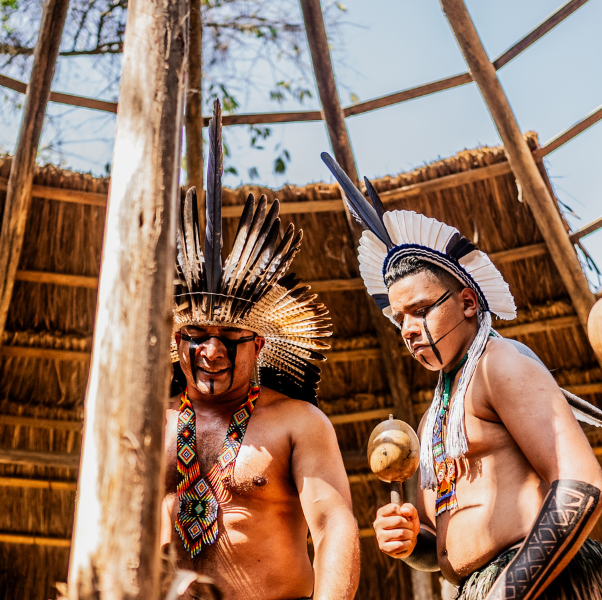INDIGENOUS PEOPLES AND LOCAL COMMUNITIES

This new opportunity must respect local traditions and knowledge, avoiding processes of cultural dispossession. It is necessary to ensure that communities are not exploited by external actors through abusive practices and that benefits are distributed fairly. Contracts and information related to biodiversity credits must be understandable to communities, and community agreements on the use of resources must be carried out inclusively and participatively. It is essential to guarantee that the entire process of generating biodiversity credits by IPLCs respects the legislation governing the rights to Indigenous Lands in each country, ensuring the feasibility analysis of rights to credits. Finally, it is necessary to ensure that the assessment for generating biodiversity credits is conducted properly and transparently, supported by technical and scientific indicators that confirm that the areas where credits are being generated deliver the expected results for biodiversity conservation.
It is crucial that biodiversity credit projects are developed in a participatory manner, respecting the rights and autonomy of Indigenous peoples and traditional communities. Therefore, enabling the involvement of these actors and the associations that represent them in the development of specific regulations for biodiversity credits in their territories is fundamental to ensuring that biodiversity credit projects are fair, effective, and sustainable over time.
With over 16 years of expertise in biodiversity metrics, the LIFE Institute is working on defining objective criteria for the certification of biodiversity credits in Indigenous Lands and Local Traditional Communities.
This process includes the following steps:
Workshop in partnership with the Avina Foundation: “Developing recommendations and a risk map to improve the implementation of biodiversity credit projects for IPLCs.”
Collaboration with the Parintin BioCredits Project, executed by InCarbon in partnership with MPA (Meu Pé de Árvore), NGO Kanindé, and Hunim (Amazon Impact Business Hub), funded by CNPq.
Pilot project(s): If you are interested in participating or supporting the implementation of a pilot, please send your message with the subject “IPLC-Pilot” to life@lifeinstituteglobal.org.
Public Meetings for stakeholder engagement. Currently in the planning phase. If you are interested in receiving updates, please send a message with the subject “IPLC-Meetings” to life@lifeinstituteglobal.org.
Public Consultation to receive comments and suggestions on the LIFE Biodiversity Credit Rules for IPLCs. Currently in the planning phase. If you are interested in participating, please send a message with the subject “IPLC-Public Consultation” to life@lifeinstituteglobal.org.
Details of Step 1: Workshop – completed (details below on page).
Date: October 24, 2024
Time: 2:00 p.m. – 5:30 p.m.
Location: Exchange Center – Place Quebec – Valle del Pacífico Convention Center, Blue Zone, COP 16 – Cali, Colombia.
Organized by the LIFE Institute in partnership with the Avina Foundation, the program included representatives of Indigenous Peoples (Parintintins and COIAB) and the financial sector (Ter Investimentos and |Xau Conservation). The event brought together 40 participants, including representatives of local communities, Indigenous peoples, civil society organizations, and financial institutions.
Aiming to foster effective and collaborative dialogue among different stakeholders, the event contributed to the inclusion of IPLCs in the biodiversity agenda. Risks and opportunities for the implementation of biodiversity projects in these territories were identified, and preliminary recommendations were developed to strengthen collaboration between IPLCs and financial stakeholders.




Guiding principles of this work
Respect and Inclusion
Engaging Indigenous communities from the outset ensures that their traditional knowledge and cultural practices are respected and integrated into the project. This also fosters an inclusive and collaborative approach.
Model Validation
Validating the effectiveness and feasibility of the biodiversity credit model in a real-world context through pilot application. This helps identify potential issues and make necessary adjustments before large-scale implementation.
Capacity Building and Empowerment
The participation of Indigenous communities in the pilot process strengthens their capacities and empowers them to manage and benefit from conservation projects.
Risk Minimization
Pilot tests help identify and mitigate potential risks, such as conflicts of interest, adverse environmental impacts, and social justice issues, ensuring that projects are sustainable and equitable.
Transparency and Trust
Broadly involving Indigenous communities in the pilot promotes transparency and helps build trust among all stakeholders, increasing acceptance and project success.
Economic and Social Benefits
A successful project can generate direct economic benefits for communities, such as revenues from the sale of biodiversity credits, while improving social well-being and environmental conservation.
Official Recognition of Territories
Ensuring alignment of the territory with the IUCN Protected Area Management Categories System or a similar system approved by local legislation.


